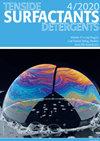不同磺化剂在用过的食用油合成甲酯磺化反应中的性能比较
IF 1.2
4区 工程技术
Q4 CHEMISTRY, APPLIED
引用次数: 0
摘要
摘要甲基酯磺酸盐(MES)是一种新型高效表面活性剂,是清洁产品中的主要活性成分。MES通常通过用磺化剂对甲酯(ME)进行磺化来生产。本研究以废食用油(UCO)为原料,通过酯交换反应合成ME,然后使用两种不同的磺化剂(氯磺酸(CSA)和亚硫酸氢钠(NaHSO3))磺化生产MES。考察了温度、磺化剂/ME摩尔比和时间等因素对MES收率的影响。使用不同的技术(GC-FID、FTIR和1H NMR)对最佳MES样品进行分析。最大MES产量为88.2 % 在70时CSA/ME摩尔比为1.2:1 3°C h,而最高MES产量为79.4 % 以1.2:1的NaHSO3/ME摩尔比获得 在90 3°C h.FTIR和1H NMR分析显示,MESCSA和MESNaHSO3样品中存在甲基(CH2−不对称和CH2−对称拉伸振动)、酯(C=O、C–O和O–CH3)和磺酸酯(S=O)基团,从而确认了所需产物。表面张力分析表明,MESCSA和MESNaHSO3具有0.079的低临界胶束浓度 g/L和0.14 g/L,而相应的表面张力为51.9 mN/m和30.94 对于MESCSA和MESNaHSO3分别为mN/m。本文章由计算机程序翻译,如有差异,请以英文原文为准。
Comparing the performances of different sulfonating agents in sulfonation of methyl esters synthesized from used cooking oil
Abstract Methyl ester sulfonate (MES) is considered as an efficient and novel surfactant used as main active ingredient in cleansing products. MES is often produced via sulfonation of methyl ester (ME) with sulfonating agent. In this study, ME was synthesized from used cooking oil (UCO) via transesterification and then sulfonated to produce MES using two different sulfonating agents (chlorosulfonic acid (CSA) and sodium bisulfite (NaHSO3)). The influence of various factors (temperature, sulfonating agent/ME molar ratio and time) on MES yield was investigated. Analysis of optimal MES samples was carried out using different techniques (GC-FID, FTIR and 1H NMR). The maximum MES yield of 88.2 % was achieved with CSA/ME molar ratio of 1.2:1 at 70 °C for 3 h while the highest MES yield of 79.4 % was obtained with NaHSO3/ME molar ratio of 1.2:1 at 90 °C for 3 h. FTIR and 1H NMR analyses revealed the presence of methyl (CH2− asymmetric and CH2− symmetric stretching vibrations), esters (C=O, C–O, and O–CH3), and sulfonate (S=O) groups in MESCSA and MESNaHSO3 samples, thereby affirming the desired product. Surface tension analysis showed that the MESCSA and MESNaHSO3 have low critical micelle concentrations of 0.079 g/L and 0.14 g/L, respectively while the corresponding surface tensions were 51.9 mN/m and 30.94 mN/m for MESCSA and MESNaHSO3 respectively.
求助全文
通过发布文献求助,成功后即可免费获取论文全文。
去求助
来源期刊

Tenside Surfactants Detergents
工程技术-工程:化工
CiteScore
1.90
自引率
10.00%
发文量
57
审稿时长
3.8 months
期刊介绍:
Tenside Surfactants Detergents offers the most recent results of research and development in all fields of surfactant chemistry, such as: synthesis, analysis, physicochemical properties, new types of surfactants, progress in production processes, application-related problems and environmental behavior. Since 1964 Tenside Surfactants Detergents offers strictly peer-reviewed, high-quality articles by renowned specialists around the world.
 求助内容:
求助内容: 应助结果提醒方式:
应助结果提醒方式:


